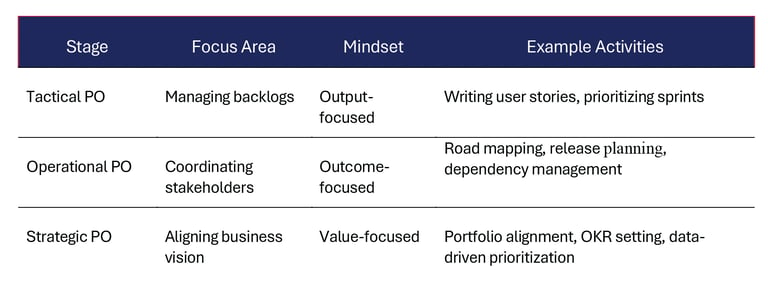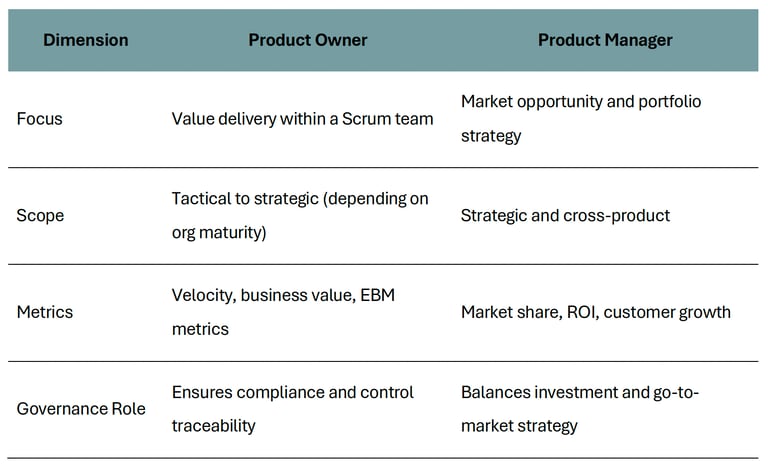
The Strategic Product Owner
The Product Owner role has evolved beyond backlog management. Discover how Strategic Product Owners combine Scrum.org principles, evidence-based metrics, and risk governance frameworks to drive enterprise agility and compliance in today’s AI-driven organizations.
Arun Natarajan
5 min read
Beyond Backlogs - The Rise of the Strategic Product Owner
In the agile transformation journey of most enterprises, one role has evolved more dramatically than others: the Product Owner (PO). Once viewed as a tactical backlog manager, the Product Owner today is increasingly a strategic linchpin — shaping business vision, governing priorities, and ensuring regulatory, customer, and risk alignment.
Scrum.org defines the Product Owner as “accountable for maximizing the value of the product resulting from the work of the Scrum Team.” But in modern enterprises — especially in regulated sectors like banking, healthcare, and government — this accountability extends beyond the Scrum Team. The Strategic Product Owner must now connect strategy with delivery, value with governance, and innovation with control.
This article explores how the Product Owner role evolves from operational execution to strategic product leadership — blending agile principles, product management frameworks, and compliance awareness to drive sustainable enterprise value.
Understanding the Core - Product Ownership in Scrum
At its foundation, the Product Owner role in Scrum exists to maximize value. According to the Scrum Guide (2020):
The PO owns the Product Goal, Product Backlog, and value delivery.
They act as the single source of truth for product priorities.
They collaborate closely with the Scrum Team and stakeholders.
In practice, this means translating customer needs and organizational objectives into incremental deliverables that can be shipped, validated, and improved.
However, real-world complexity demands more than incremental delivery. In an enterprise environment, “value” is multi-dimensional — including financial ROI, compliance, security posture, and customer trust. That’s where strategic product ownership begins.
From Tactical to Strategic: The Product Owner Maturity Curve
Most organizations experience a maturity curve for their Product Owners:
At the strategic level, the PO is not just reacting to inputs — they shape demand, influence priorities across teams, and ensure regulatory and operational soundness.
Strategic Product Ownership Framework
To operate effectively at scale, a Strategic PO aligns with three core dimensions:
A. Strategic Alignment
· Link product outcomes to enterprise OKRs or Balanced Scorecards.
· Ensure every backlog item contributes to measurable strategic goals.
· Use value stream mapping to trace how features contribute to business KPIs.
B. Value Governance
· Apply evidence-based management (EBM) from Scrum.org to measure current value, unrealized value, and innovation rate.
· Use risk frameworks (e.g., FAIR, NIST CSF, ISO 42001) to assess technology and AI-related risks.
· Maintain traceability between customer value, regulatory compliance, and operational controls.
C. Adaptive Delivery
· Balance innovation velocity with risk appetite.
· Integrate agile governance through stage gates that validate outcomes, not documents.
· Foster transparency using metrics dashboards — lead time, escaped defects, value delivered per sprint, etc.
Anchoring in Industry Frameworks
The Strategic Product Owner bridges Agile Product Management and Enterprise Governance. Below are key frameworks and their relevance:
In regulated industries, the Strategic Product Owner is often also a governance partner — ensuring that value delivery complies with laws, policies, and ethical AI standards.
Strategic Product Owner Competencies
To succeed in this expanded role, a Strategic PO requires a blend of business acumen, leadership, and regulatory literacy.
Core Competencies
1. Value Management – Quantify value through EBM, ROI, and OKR metrics.
2. Stakeholder Influence – Navigate between customer needs, risk, compliance, and technology.
3. Regulatory Awareness – Understand frameworks like SR 11-7, DORA, ISO 27001, and their implications for product governance.
4. Strategic Thinking – Connect roadmap items to the enterprise’s strategic themes.
5. Technical Literacy – Understand architecture, APIs, AI/ML models, and cloud delivery pipelines.
6. Risk-Informed Prioritization – Balance innovation opportunities with regulatory and operational risks.
Strategic PO as a Governance Partner
A product owner in a bank, for instance, must constantly balance innovation with safety and soundness.
Example:
· A new AI model proposed for customer onboarding may enhance speed but introduce bias risk.
· A Strategic PO aligns with compliance officers to evaluate explainability, model validation, and bias mitigation steps.
· Product delivery is adapted to NIST AI RMF or ISO 42001 controls, ensuring responsible innovation.
This governance partnership transforms the PO from a “feature manager” to a strategic risk mitigator and trust enabler.
Tools and Techniques for Strategic POs
1. Value Frameworks
· EBM (Evidence-Based Management): Evaluate Current Value, Unrealized Value, Time to Market, and Ability to Innovate.
· OKRs: Set measurable outcomes tied to business strategy.
2. Prioritization Models
· WSJF (Weighted Shortest Job First): Optimize sequencing by cost of delay.
· Risk-Adjusted Backlogs: Include compliance, technical debt, and risk remediation as first-class backlog items.
3. Road mapping Tools
· Productboard, Jira Align, Azure DevOps: Align feature roadmaps with value streams and governance milestones.
4. Metrics Dashboards
· Combine delivery metrics (velocity, lead time) with value metrics (ROI, customer satisfaction).
· Integrate tools like Tableau, Power BI, or Jira dashboards.
Scaling Product Ownership Across the Enterprise
At scale, individual POs must collaborate under a Product Ownership Community of Practice (CoP) to ensure consistency in governance and outcomes.
Key practices include:
· Cross-PO Syncs for dependency management and shared OKRs.
· Portfolio Kanban to visualize investment flow.
· Governance scorecards to ensure transparency on value vs. compliance trade-offs.
A Chief Product Owner (CPO) or Product Director often orchestrates this alignment, ensuring that each team’s backlog ties to strategic enterprise value.
Leading with Data: Evidence-Based Product Ownership
Strategic POs lead through data, not anecdotes.
Scrum.org’s EBM identifies four Key Value Areas (KVA):
1. Current Value (CV): How much value the product delivers now.
2. Unrealized Value (UV): Potential future opportunities.
3. Time-to-Market (T2M): How quickly value is delivered.
4. Ability to Innovate (A2I): How effectively the organization can adapt.
Example:
A Strategic PO at a global bank used these metrics to measure model validation automation:
· CV: Reduced manual validation effort by 40%.
· UV: Estimated 60% efficiency gain if scaled to 10 models.
· T2M: Cut validation cycle from 30 to 7 days.
· A2I: Enabled continuous monitoring pipelines.
The Strategic PO in AI and Emerging Tech Products
AI, ML, and GenAI products introduce unique complexities:
· Data governance: Who owns the data? How is it sourced?
· Model explainability: Are outputs transparent and reproducible?
· Regulatory compliance: How do we comply with NIST AI RMF or the EU AI Act?
A Strategic PO partners with data scientists, model validators, and compliance teams to integrate responsible AI principles directly into the backlog:
· “As a compliance officer, I need every model output logged and auditable.”
· “As a customer, I need assurance that AI decisions are fair and unbiased.”
This integration transforms AI delivery from experimentation to governed innovation.
Building Strategic PO Capability in Organizations
To institutionalize strategic product ownership:
· Establish PO Career Paths (Associate → Product Owner → Strategic Product Owner → Product Director).
· Create training paths using Scrum.org PSPO II / III, SAFe POPM, and Lean Portfolio Management certifications.
· Promote cross-functional rotations between PO, compliance, and architecture teams.
· Invest in mentoring and CoPs for peer learning.
A well-designed PO ecosystem becomes the engine of enterprise agility.
Strategic Product Owner vs. Product Manager
In mature enterprises, the Strategic PO often bridges the two roles, translating strategy into compliant, incremental execution.
Measuring Success: KPIs for Strategic Product Ownership
· Value Delivered: % of backlog aligned to measurable business outcomes.
· Customer Impact: NPS / satisfaction improvement.
· Regulatory Alignment: Audit issues remediated via product features.
· Agility Metrics: Lead time, throughput, predictability.
· Innovation Health: % of budget allocated to experiments.
When tracked transparently, these metrics reinforce trust and credibility with leadership.
The Future: Product Owners as Value Stewards
In a world driven by AI, cloud, and regulatory reform, tomorrow’s Product Owner will resemble a mini-CEO — managing vision, governance, and outcomes.
They won’t just build products; they’ll shape ecosystems that deliver compliant innovation at scale.
The Strategic Product Owner is no longer a participant in the agile process — they are a strategic steward of enterprise value.
Download this article in PDF format: eBook
External References:
· Scrum.org: Product Owner Accountability
· Scrum.org Evidence-Based Management Guide
· Scaled Agile Framework (SAFe)
· NIST AI Risk Management Framework
· ISO/IEC 42001:2023 Standard for AI Management System
For more interesting contents, follow me on
© PRODCOB.com | @brownmansocial | www.linkedin.com/in/arun-natarajan


The Strategic Product Owner: Orchestrating Vision, Value, and Velocity in the Enterprise






